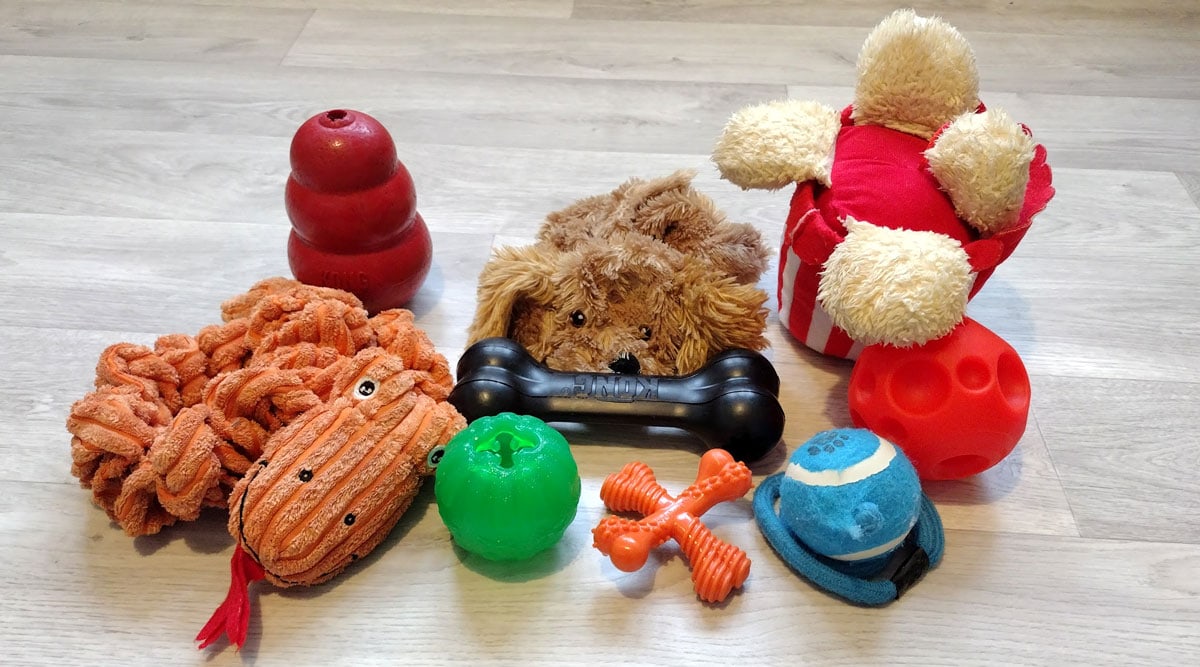
It can be challenging to choose the best dog toys for your pet. Thousands of options are available, and not all dog toys are fun, high-quality, or even safe!
With help from experienced IMDT dog trainer Rebecca Morello, we’ve compiled our list of the best dog toys on the market. We’ve included a range of different toy types, so there’s an option for every dog. Let’s get straight to our top picks!
Top Recommendations
- Best Flavored Chew Toy: Nylabone Power Chew Toy
- Best Chew Toy for Aggressive Chewers: West Paw Zogoflex Rumpus
- Best Durable Tug Toy: Monster K9 Ultra-Durable Chew Toy
- Best Dog Ball: Chuckit! Ultra Ball
- Best Frisbee: Kong Flyer
- Best Rope Toy: Mammoth Cottonblend Rope
- Best Teething Toy: Petstages Puppy Teething Toy
- Best Soft Toy: goDog Skinny Dragon With Chew Guard
- Best Non-Stuffing Soft Toy: ZippyPaws Skinny Peltz
- Best Puzzle Toy: Kong Wobbler
- Best Snuffle Mat: PAW5 Wooly
- Best Stuffable Toy for Chewers: Kong Extreme Goodie Bone
Contents
- Top Recommendations
- 12 Best Dog Toys (Including Chew, Rope, Teething and Puzzle Toys)
- 1. Nylabone Power Dog Chew Toy
- 2. Monster K9 Ultra-Durable Chew Toy
- 3. Chuckit! Ultra Ball Chase Dog Toy
- 4. Kong Flyer Frisbee
- 5. Mammoth Flossy Chews Cottonblend Rope Tug Toy
- 6. Petstages Puppy Teething Toy
- 7. goDog Skinny Dragons with Chew Guard (Soft Toy)
- 8. ZippyPaws Skinny Peltz No Stuffing Toy
- 9. Kong Wobbler Puzzle Toy
- 10. PAW5 Wooly Snuffle Mat
- 11. West Paw Zogoflex Rumpus Chew Toy for Aggressive Chewers
- 12. Kong Extreme Goodie Bone
- How We Chose Our Favorite Dog Toys
- What Makes a Great Dog Toy?
- What Are The Different Types of Dog Toys?
- Which Type Should You Choose?
- Dog Toy Safety: A Trainer’s Perspective
- Why Dogs Need Lots of Toys and Playtime
- Tips for Introducing Toys and Teaching Dogs How to Play
- Summary
12 Best Dog Toys (Including Chew, Rope, Teething and Puzzle Toys)
Nylabones are non-edible, bone-style toys designed for dogs who love to chew. They come in many shapes, densities, and textures, so we’ve found them to be a favorite toy for many dogs.
Our top pick from this company is the Nylabone Power Chew. This version has a beef flavoring to hold your dog’s interest, while the shape makes it easier for your dog to get a good grip. We also found that it’s also very tough and can hold up against most dogs, although it’s not completely indestructible.
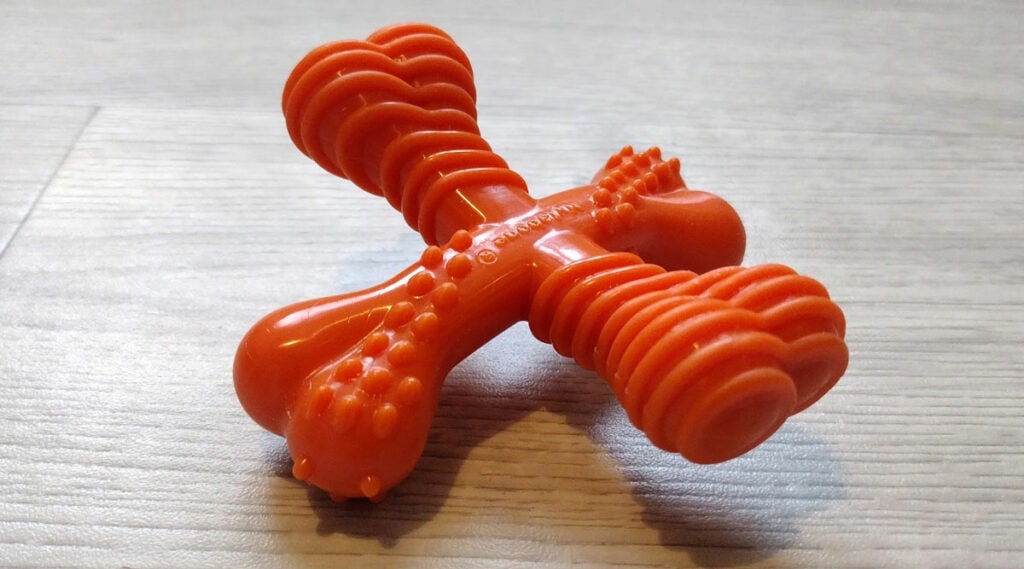
We like that Nylabone chews are easy to clean and can help with dental hygiene. They are also a good alternative to rawhide or other edible chews, which are more likely to cause tummy upsets or blockages.
There are a few drawbacks though. We found that some dogs find them boring, due to the lack of flexibility, bounce, or squeaker. Some veterinary dental specialists also caution the hard nylon means there’s a small risk of a tooth fracture or chip. Additionally, bits that are broken off by strong chewers could be a choking hazard, which is why supervision is always required.
Note: The toughest Nylabone versions are not recommended for young dogs with puppy teeth. There are puppy-specific versions that are a better choice.
The Nylabone Power Chew is an ultra-durable dog chew toy with a tasty flavor. It’s not the most exciting dog toy, but we found that it’s great for chewers.
- Type of Toy: Durable Chew Toy
- Brand: Nylabone
- Price Range: $$
- Highly durable chew toy
- Flavored dog chew
- Can help with dental hygiene
We think the Monster K9 Chew Toy is one of the few toy options for aggressive chewers. It’s made from industrial-strength rubber material, making it one of the toughest dog toys on the market.
Unlike the Nylabone chew, we found the ring design means the Monster K9 can be used for fetch or tug-of-war. This makes it a more versatile toy, especially for human-dog playtime.
However, we found that the ultra-durable design means it is heavy and doesn’t have much bounce. This dog toy also has no squeaker and isn’t particularly interactive, so unless your dog is a big chewer, you may want to opt for something more engaging.
While this is one of the more robust dog toys on the market, it still isn’t completely chew-proof, and power chewers could break pieces off if they’re determined enough. You shouldn’t leave your dog unsupervised with this if they’re an aggressive chewer.
The Monster K9 Chew Ring is one of the toughest dog toys on the market. Made with industrial-strength rubber, it’s a good choice for strong chewers. We also like the ring design, as it makes it more suitable for tug games.
- Type of Toy: Durable Chew Toy
- Brand: Monster K9
- Price Range: $$
- Strong rubber dog toy
- Non-toxic and safe for dogs
- Can be used for games of fetch or tug
The Chuckit Ultra Dog Ball comes in four sizes and is much more durable than a traditional tennis ball. During our tests, we found it had excellent bounce and was great for a game of fetch or “find it.” As it can be wipe-cleaned, we also like that you don’t need to worry about the Chuckit getting clogged with slobber or muck.
Additionally, the flexible rubber is much better for your dog’s teeth than the abrasive material of a traditional tennis ball. Dogs that regularly play with balls can suffer from blunting of their teeth, as a result of the tennis ball scouring them down, so this is a big advantage of the Chuckit.
Make sure you pick an appropriate size ball for your dog though. If you go too small, there is a greater chance of your dog accidentally swallowing the ball or it getting stuck in their throat.
Also, while these balls are tough, they’re not designed to be chewed. If you have an aggressive chewer, it’s best not to leave them on their own with these balls unsupervised. For fetch, however, we think the Chuckit is a brilliant dog toy.
Note: Avoid playing fetch with a ball launcher, as these can cause your dog to overexert and strain themselves. The high speed of the ball is also dangerous if it bounces at the wrong angle. Some dogs become obsessive when playing fetch, so we recommend keeping this game to a minimum. Instead, “find the ball” is often a better alternative.
During our testing, we found that the ChuckIt! Ultra Ball is one of the best balls for dogs. It’s great for fetch and safer than a regular tennis ball.
- Type of Toy: Fetch Toy
- Brand: Chuckit!
- Price Range: $
- Great value
- Safer for dogs than a tennis ball
- Decent bounce
Our favorite dog frisbee is the excellent Kong Flyer. We love Kong products, and during our tests, we found that the Flyer is a great example of a toy that’s both fun and durable.
The Kong Flyer comes in two rubber density options. Both are durable, but the red is more flexible and slightly softer, which we prefer for smaller dogs. The black version is heavier but stronger, and designed to withstand attention from the most powerful jaws.
The Flyers are also available in two sizes and are wipe-clean. While they are primarily designed for fetch, we found that they can make a strong dog toy for tug-of-war.
Because Kong Frisbees still have flex in them, they are less likely to cause teeth damage if caught mid-flight. The flex also means you can fold the frisbee into a pocket, so you don’t have to carry it between play sessions. However, the Kong Flyer is not a chew toy, so always supervise chewers when playing with this toy.
The Kong Flyer is one of the best dog frisbees on the market. It’s strong, flexible so it’s safer to catch, and provides great value for money.
- Type of Toy: Fetch Toy
- Brand: Kong
- Price Range: $$
- Strong frisbee for dogs
- Flexible for extra safety when catching
- Two strength options
We’re big fans of these multi-knot dog rope toys from Mammoth, as they come in several sizes and are made from a cotton blend. We found that they are strong, durable, and the knots make it easy for your dog to grip.
Providing you teach your dog a release command and allow them to do the pulling, we found that playing tug with Mammoth ropes can be a great way to work on impulse control and bonding with your dog. Many dogs love tug-of-war – especially with toys that are easy to hold. However, you should avoid pulling the toy, as the added force can cause over-stimulation and potentially cause injuries to your dog.
Another thing we liked about the Mammoth is that the cotton blend provides a teeth-flossing effect during play. They are also heavy-duty and tightly woven, so will stand up to rough ragging.
Although cheaper than many rubber alternatives, rope dog toys aren’t as robust or suitable for power chewers. Keep an eye on your dog whenever they are playing with rope, as cotton string can be dangerous if ingested.
If your dog loves ropes, the Mammoth Flossy is one of our top picks. It’s available in several sizes and has multiple knots for your dog to grab.
- Type of Toy: Tug Toy
- Brand: Mammoth
- Price Range: $
- Durable for a rope toy
- Multiple knots
- Cotton blend provides a mild teeth flossing effect
The Petstages teething stick isn’t designed for aggressive chewers, but we found that it’s great for puppies going through the teething stage.
This toy is multi-textured, with knotted streamers, flags, and ribbons attached to it. The more variation the better when it comes to holding your pup’s interest, so we love the different parts of the toy. We also found that it’s flexible enough to prevent damage to your pup’s delicate teeth.
The toy can also be soaked and frozen. The cold temperature is great for soothing your puppy’s inflamed and sore gums.
It isn’t the biggest toy though, so we don’t think it’s the best choice for large breeds. Being made from a cotton and polyester fabric, it also isn’t the toughest. You’ll need to supervise your pup to make sure they don’t chew off and ingest any of the fabric appendages.
The Petstages Dog Toy is a great option for puppies who are teething, due to the multiple textures and freezer-safe design.
- Type of Toy: Teething toy
- Brand: Petstages
- Price Range: $
- Can be frozen for a soothing effect
- Multiple textures
Soft dog toys are never going to withstand aggressive chewers. However, if your dog enjoys soft squeakers, or just likes to carry a comforter, we’ve found that the goDog range is considerably tougher than the average soft dog toy.
The goDog Dragon has a tough liner and reinforced stitching to maximize the longevity of the toy. We like that it has a squeaker to find, plus crinkly wings for additional enrichment.
You can also use it to play tug-of-war, provided your pet isn’t too rough. Additionally, it’s machine washable for quick cleaning, which is important for a soft toy.
Still, there’s a limit to how durable a soft toy can be. If your dog is determined to destroy it, they will (and fast if they are a strong chewer!) The wings, tails and legs all make easy targets. We found that these toys are best suited to dogs that prefer to ‘baby’ their toys rather than destroy them.
The goDog Skinny dragon is a plush toy that’s stronger than the average soft toy. This is due to the chew-guard technology. It also has a squeaker and crinkly wings, making it one of the best soft toys on the market.
- Type of Toy: Plush Toy
- Brand: goDog
- Price Range: $
- Chew guard technology makes it more durable than most soft toys
- Squeaker and crinkly wings
The Zippypaws Skinny Peltz is a great example of a soft toy that doesn’t contain any stuffing. This makes it safer for chewers who might otherwise eat a toy’s stuffing – particularly if they have a habit of ripping soft toys!
We like that the Zippypaws have three squeakers to keep dogs entertained, as a squeak always makes a toy a hit. We also found that these toys are surprisingly strong for a soft toy. Mild chewers probably won’t do much harm and they provide great value for money.
Unstuffed soft dog toys are not designed for power chewers though. The squeakers could still be dangerous if eaten, so it’s important to supervise your pet when playing with this toy.
The ZippyPaws doesn’t have any stuffing, which is great if your dog has a history of destroying soft toys. We also found that it’s relatively durable (for a soft toy) and includes three squeakers.
- Type of Toy: Plush Toy
- Brand: ZippyPaws
- Price Range: $
- No stuffing
- Contains three squeakers
- Great value
If you’re looking for a durable puzzle toy that can give your dog a mental challenge, then the Kong Wobbler is one of our favorite choices. It’s similar to an IQ treat ball but has a “wobbling” design that makes it more interesting. During our testing, we found that many dogs love the challenge of getting food from this toy.
The Kong Wobbler is weighted at the base and can be opened to put treats or kibble inside. Your dog then must learn to tip it over to allow the goodies to be released from a small treat hole. It comes in two sizes, meaning it’s suited to most breed types, except the tiniest toy breeds.
As you would expect from Kong, during our tests, we found the Wobbler is a durable and high-quality toy. Made from a food-grade polymer plastic, we like that it can be separated and put in the dishwasher. It’s also a simple toy, so there’s nothing for your dog to break off and swallow.
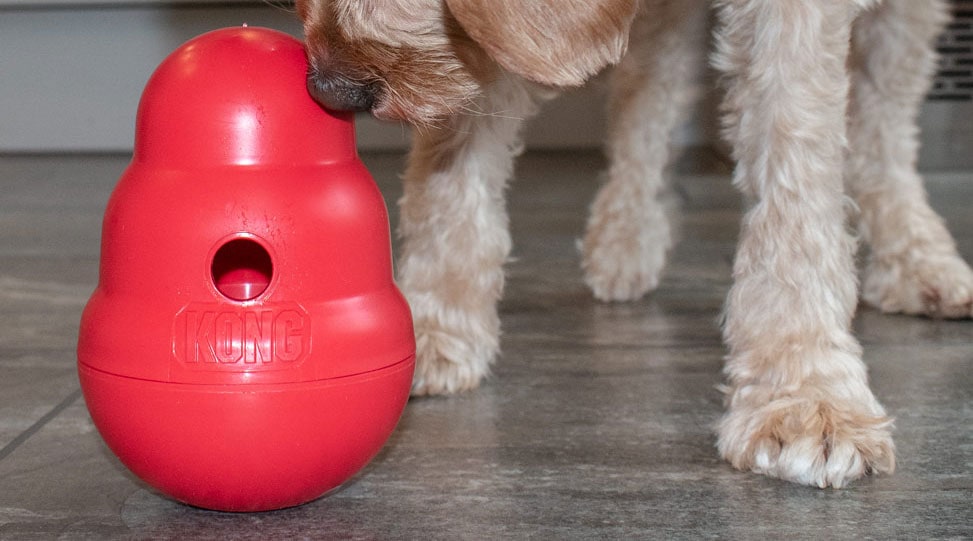
The Kong Wobbler might not be the perfect choice for nervous dogs though. We found that it’s noisy when rolling around the floor or hitting furniture, plus it “wobbles” back towards the dog. We also think it would benefit from a non-slip base, as during our testing, the dog often just batted it around on hard floors.
Additionally, while very tough, the Wobbler isn’t indestructible and is best suited to supervised play. Some dogs will also need guidance to show them how it works, although it’s easier than some of the more complicated puzzle feeders we’ve tested. It’s also only suitable for dry kibble or treats. A Classic Kong is a better option for moist, home-cooked, or raw food.
The Kong Wobbler is a wonderful puzzle toy that’s great for making your dog “think” for their meal. It’s a simple toy that’s highly durable, making it one of our top picks for a puzzle feeder.
- Type of Toy: Puzzle Feeder
- Brand: Kong
- Price Range: $$ – $$$
- One of our favorite dog puzzle toys
- Highly durable
- Great for a dog owner who wants to slow down their pet’s meals
If you’re looking for a simple snuffle mat to encourage natural foraging behaviors, then the PAW5 Wooly is our top pick. This mat contains tightly woven fabric lengths that mimic long grass. During our tests, we found that our dogs loved sniffing for food and treats scattered throughout the mat.
One of the great things about the PAW5 Wooly mat is that it’s suitable for dogs of all ages, sizes, and mobility levels, making it one of the most versatile dog toys on the market. It’s also easy to wash, as it can go in a washing machine, and provides endless fun at mealtimes.
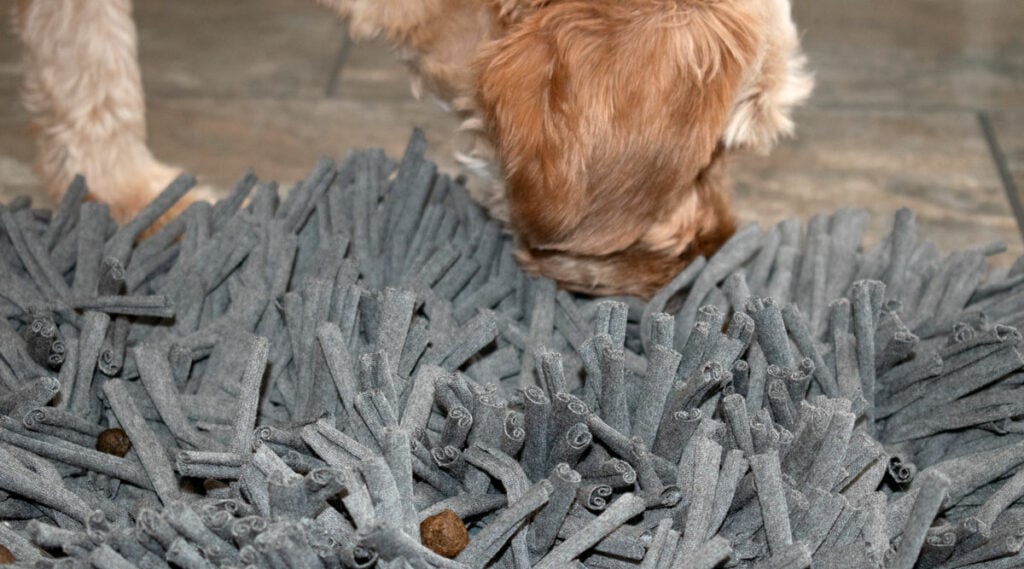
The PAW5 isn’t a chew-proof toy though. You may need to supervise your dog to prevent them from getting too over-enthusiastic or pulling out the “grass.” It’s also relatively expensive, although we still think it’s worth the money.
Did You Know…snuffle mats don’t just make meals more interesting for your dog. Studies have shown that allowing your dog to put their nose to work can help them feel more optimistic and improve their confidence.
The PAW5 is one of our favorite snuffle mats and an excellent treat dispensing toy. It has a simple design, but the grass-like strands are great for hiding kibble and treats. Our dogs loved it!
- Type of Toy: Puzzle Feeder
- Brand: Paw5
- Price Range: $$$
- Fabric strands provide plenty of hiding spots
- Great for getting your pet to use his nose
- Machine washable
For serious power chewers, the West Paw Zogoflex Rumpus is our top pick. It’s ultra-durable and dishwasher-safe, meaning it’s easy to maintain and lasts a long time. We’re also impressed by how West Paw tested the Rumpus with strong dogs to ensure it’s as close to chew-proof as you can get.
The Rumpus isn’t the most interesting toy, but we found that it has a great bounce and can stand up to harsh treatment. It also comes in two sizes, which works for most dog breeds. It’s a shame that there’s no way to stuff food inside this toy to make it more interesting though.
While no toy is completely indestructible, we think the Rumpus comes pretty close. It’s certainly more than a match for most dogs.
“Many brands claim their toys can withstand the toughest chewers, but West Paw is the only one I’ve found that holds up so far,” says Rebecca Morello, IMDT dog trainer. “When I was working with rescue dogs at a rehoming center, we had a Dogue de Bordeaux cross Mastiff called Frank who destroyed everything. We bought him a West Paw Rumpus toy, and he didn’t make a dent!”
The ZogoFlex Rumpus is one of the toughest products on this list. It has a decent bounce and is almost indestructible (no dog toy is 100% chew proof), so we think it’s one of the best for dogs who love to chew.
- Type of Toy: Tough Chew Toy
- Brand: West Paw
- Price Range: $$
- One of the best dog toys for chewers
- Three chew lobes
- Made in the USA
The black “Extreme” range is the toughest in the Kong product line. This means the Kong Extreme Goodie Bone doesn’t have as much flex as the Classic range, but for power chewers we found it’s the most sensible choice.
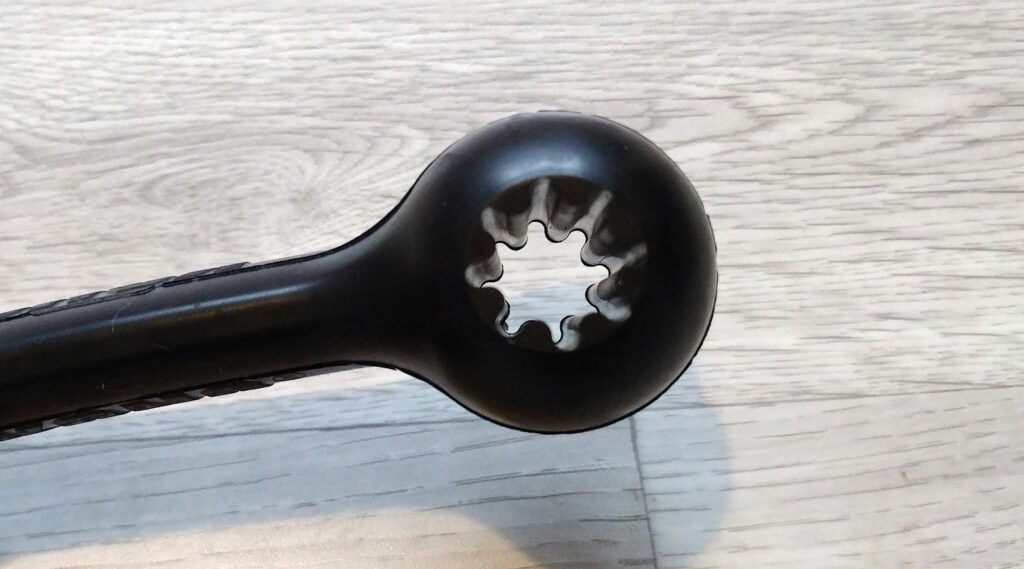
The Extreme Goodie Bone has hollow ends on either side of the bone. During our testing, we liked how these can be used to stuff chew sticks and biscuits, which made the toy more interesting than the West Paw Rumpus. To increase the challenge, you can even freeze moist food, such as peanut butter or banana.
While it’s highly durable, we don’t think it’s quite as chew-proof as the West Paw Rumpus. If you have an aggressive chewer with strong jaws, the Kong Extreme Goodie Bone may not last. Most dogs are unlikely to break this toy though.
- Type of Toy: Tough Interactive Toy
- Brand: Kong
- Price Range: $$
- Extremely tough rubber toy
- Can be stuffed with peanut butter (or other dog-safe spreads) to make it more interesting
- Made in the USA
How We Chose Our Favorite Dog Toys
Our team of dog trainers, vets, and other experts has a huge amount of experience with hundreds of different dog toys. We know which ones are fun toys – and which are unlikely to last more than a brief play session!
For this reason, we narrowed down our selection of dog toys based on a combination of our own experience and buyer reviews. Once selected, we then purchased any of the toys we didn’t have direct experience with so we could test they were:
- Durable
- Safe
- Met the manufacturer’s claims
- Fun for our dogs!
What Makes a Great Dog Toy?
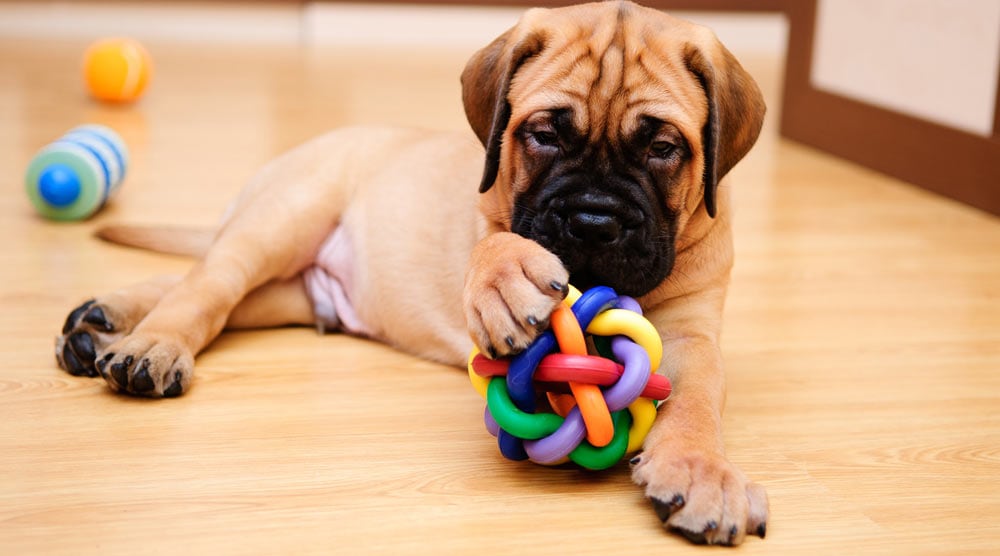
While every dog is an individual, there are certain things you should look for in any dog toy. Here are the most important factors we considered when choosing, testing, and reviewing the list of toys above.
Durability
There’s no such thing as a truly ‘indestructible’ dog toy, but you want one that will last. It should have a strong exterior and no obvious weak points your dog can target.
High-quality, dense rubber toys tend to be the most durable. Selecting a trusted brand like Kong (for moderate chewers) or West Paw (for the strongest chewers), which are known for their durability, is a good bet. If the toy has been tested by breeds known for strong jaws and chewing capabilities, this is also a good sign.
Fire hose dog toys have become a popular choice in recent years. Fire hose material isn’t as tough as dense rubber, but it provides a softer alternative that’s stronger than a typical plush toy.
Toy design also makes a difference to its durability. The fewer appendages a dog toy has, the less chance of your dog finding a target for aggressive chewing. Soft arms, ropes, and even decorations (such as buttons on a teddy) can all be weak points. On the other hand, these appendages also make the toy more interesting.
Plush toys are always less durable than rubber chews. Features like reinforced stitching and inner linings can increase durability though.
Safety
No dog toy is entirely risk-free, especially if your dog is left unsupervised. However, there are ways to minimize the risk.
Steer clear of plush options with beans for stuffing or appendages that can easily be chewed off (like glass eyes). Interior stuffing is never healthy for a dog to eat, even if the toy is non-toxic, so supervise your pet whenever he’s playing.
It’s not just soft dog toys that can be dangerous though. Rubber balls with a single air hole create strong suction that can trap the tongue and stop circulation. Hard plastic could also damage teeth.
If you know your dog is a destroyer, always select tougher options to minimize the chance of them chewing a piece off, creating a choking hazard.
Be aware of the risk of repetitive strain injury with the likes of ball-throwers, and don’t select things like lasers which your dog can become unhealthily fixated on.
Related Article: Why Sticks Are Dangerous For Dogs
Non-Toxic to Dogs
Unlike children’s toys, there are minimal regulations relating to the production of dog products. Cheap dog toys, with unknown origins, may even be manufactured with toxic materials.
Dog toys made from malleable plastic, for example, often contain polyvinyl chloride (PVC).
These vinyl options don’t tend to be very robust, and it can be easy for your dog to break off and eat a piece. More seriously, they commonly contain chemicals that can be toxic to your dog. Things like Phthalates can cause organ damage and have even been shown to increase the chance of developing cancer.
Similarly, some tennis balls often contain traces of lead. This can lead to serious gastrointestinal and nervous system issues.
In 2007, there was a report released by Consumer Affairs that claimed that toxic lead, chromium, arsenic, and cadmium were found in Chinese-sourced pet toys sold by Walmart. While some vets argued the quantities present were unlikely to present a serious health risk, selecting a toy with transparent material information makes sense.
Always do your research before buying a dog toy. At a minimum, find out where a toy is manufactured and what material it’s made from. If this information isn’t readily available, it’s best not to risk it.
To Squeak or Not to Squeak
Some dogs just won’t play with a dog toy if it doesn’t squeak. This is most common in breeds with a high prey drive, as the squeak is motivating for them. Other dogs just find the squeaking action to be self-soothing.
If your dog loves a squeaker, be aware that these toys tend to be less durable. You’ll need to supervise play carefully, as the squeaker can present a choking hazard.
Squeakers can also cause your dog to become over-aroused, so short play sessions are best – for your sanity too!
Tip: Squeaky dog toys can also be used as a zero-calorie reward during training, although they are best avoided in a class environment.
Cleanable
It’s vital that a dog toy is easy to wash. Slobber or food can gather on rubber or soft materials, and, if they can’t be cleaned properly, can harbor unhygienic germs and bacteria.
Soft dog toys should be machine washable. This makes it easy to kill any bacteria that might be living on the toy.
Hard dog toys should be quick to wipe down or rinse. Those with lots of nooks and crannies can be difficult to clean, which is something to keep in mind when buying. Some rubber is dishwasher safe, which makes cleaning much easier.

Always Supervise Your Dog During Playtime
Regardless of how durable a dog toy is, supervision is recommended. This allows you to intervene if there is a choking hazard, too much destruction, or your dog is becoming over-aroused. If a toy is showing any signs of damage, it’s best to replace them.
Don’t forget, while dog toys can be a fantastic additional source of stimulation and enrichment, they can’t replace daily exercise and attention.
What Are The Different Types of Dog Toys?
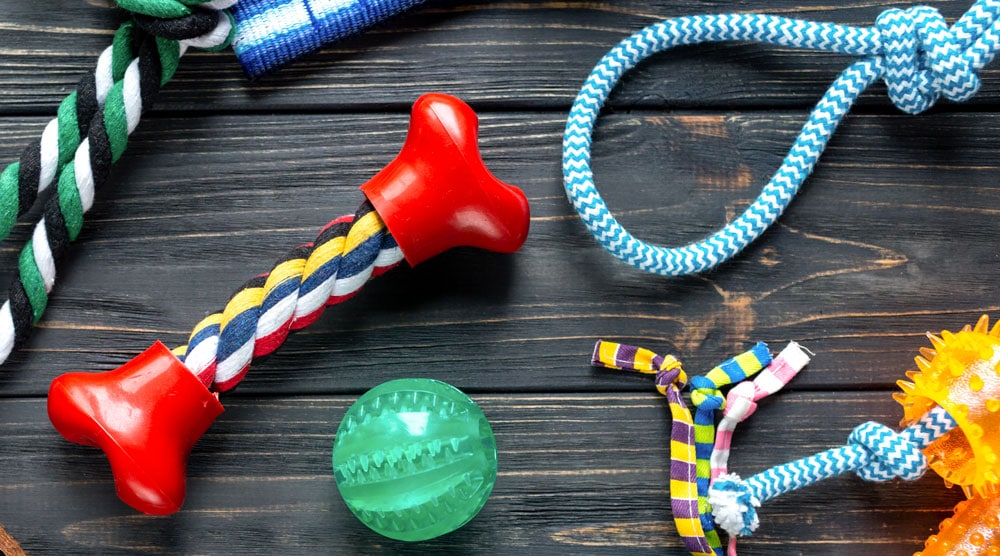
There are a variety of types of toys available. Here’s an overview of some of the most common examples:
- Hard Rubber Toys. For extreme chewers, selecting a durable dog toy made from hard, dense, and high-quality rubber is often a good choice. These can withstand a lot of rough treatment and are less likely to be ripped into small choking hazards. Some even come with a replacement guarantee if your dog manages to break it. We think the West Paw Rumpus is one of the strongest on the market and a great option in this category.
- Rope Toys. These can be a relatively inexpensive choice if you have a dog that likes to play tug or enjoys having something to rag. They can also act as a natural tooth flosser. Tug toys can be great for exercise, teaching impulse control, and bonding with your pet. Be careful using ropes with aggressive chewers, however, as pieces of string can be dangerous if eaten. You also shouldn’t pull hard, as this can cause injury and over-stimulation.
- Puzzle and Treat Toys. Interactive and brain-training toys are essential for dogs of any age. “Domestic dogs rarely get to think for themselves or have a purpose in day-to-day life, which puzzle toys can provide,” says Morello. These toys provide mental stimulation between walks and can be useful for crate training. They are also sometimes used for distracting dogs with mild separation anxiety and may even build confidence or independence. Examples include a treat dispensing toy or an IQ treat ball.
- Soft Toys. Some dogs like to have a toy as a comforter, and a soft toy is usually the best choice. Soft toys with squeakers are also fun for less aggressive chewers. “I find soft toys can be a good choice for play between kids and dogs, as the toy can’t accidentally hurt them both,” adds Rebecca Morello, IMDT dog trainer.
- Fetch Toys. If you have an active dog, then having a supply of balls, frisbees, or retrieval dummies can be beneficial. Fetch games should only be played in moderation though. Too much high-impact, repetitive activity can strain the joints and encourage obsessive behavior. These types of toys are much safer than throwing a stick, which can cause serious puncture wounds or splinters.
- Teething Toys. For puppies going through the teething phase, look for chew toys with a decent amount of “give.” They should also have different textures or be freezable. This can relieve the discomfort caused by sore gums. It also means your pup will be less likely to find something inappropriate to chew on – like your slippers!
Studies have shown that dogs are prone to ‘neophilia’ – a preference for new things. By having a variety of toys for your dog that you swap out regularly, you can keep your pet entertained and stimulated.
Which Type Should You Choose?
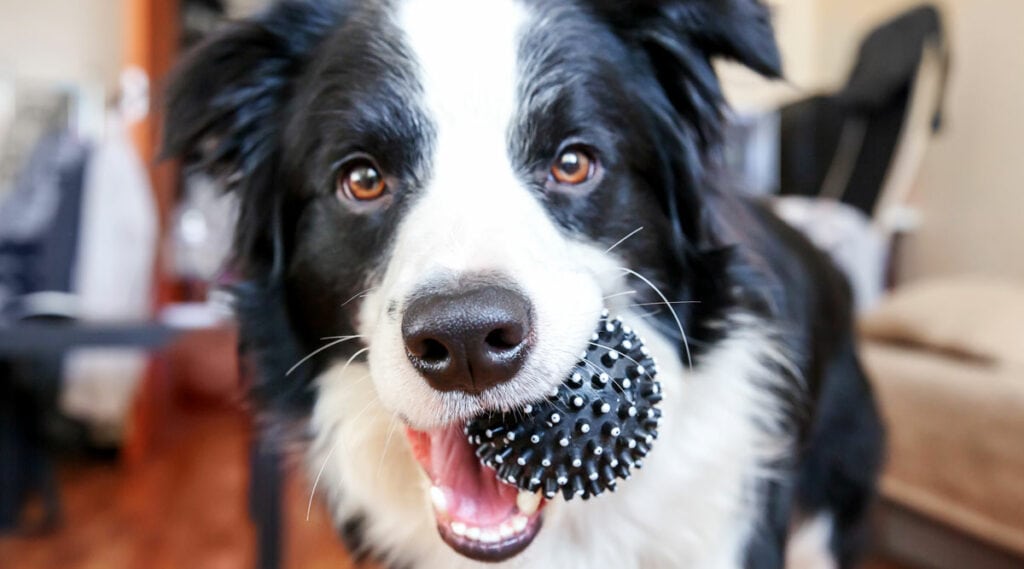
The right toy for your dog depends on their size, age, preferences, intelligence, and activity levels. Some dogs love soft and comforting toys, while others need interactive products to keep them engaged.
Dog Age
Dogs often need different types of toys as they grow up. So, your dog’s age is a key consideration when choosing toys.
Ball throwers or frisbees are generally not recommended for puppies. As young dogs are still growing, too much intense or high-impact exercise can cause damage to their soft bones and joints.
Young dogs also have a higher propensity towards chewing. You want to select tough materials, but not so hard they could damage their little teeth. Because their gums can be sore during the teething phase, selecting soothing textures or toys that can be frozen is often a good idea.
Once your dog has fully matured and has adult teeth, their strength could increase. If they continue to be an aggressive chewer, you may need to select something more robust than when they were just a pup. Heavy-duty rubber is nearly always the best option. Additionally, some toys may become a choking hazard if your dog is much bigger as an adult than when they were a puppy, so these toys should be replaced.
Your dog’s preferences may also change. They may not have such a high desire to chew, or could be more motivated by different things. Maybe your dog will develop a passion for playing fetch, or perhaps enjoy a game of tug.
With that said, you don’t always need to replace your dog’s toys as they get older. “Some dogs are entertained by some of the same toys from puppyhood all the way to their senior years,” says Rebecca Morello, IMDT dog trainer. “My dog still has her first soft toy because she was never destructive with her toys – although it’s natural for other puppies to destroy their toys too.”
If you have a senior dog with mobility issues, or one on restricted exercise, using brain training toys for your dog can be a great way to provide them with additional stimulation. Enrichment like this could even slow down the progress of cognitive aging.
Tip: If you’re adopting a new dog, you may need to experiment with various toys to find their favorite.
Dog And Toy Size
Picking the right size of dog toy is crucial. If it’s too small, the toy could become lodged in your dog’s throat. This is particularly dangerous when playing fetch with a ball. Small dog toys are also easier for the dog to destroy, as they can use the full force of their jaw muscles.
A toy that’s too big could mean your dog struggles to pick it up though. It could also be too heavy and uncomfortable for them to play with.
Don’t underestimate the power of a small dog’s jaws either. Just because they are little, doesn’t mean their teeth can’t cause damage.
Dog Breed and Natural Toy Preference
Your dog’s natural drives can influence the types of toys they’ll enjoy.
“Think about which tasks your dog was originally bred for, along with their personal play styles,” says Morello. “For example, a spaniel will likely enjoy holding and parading a big soft toy. A terrier will likely have more fun destroying the same soft toy and pulling the stuffing out!”
Here are a few examples:
- Sighthounds often love squeakers, as they want to “kill” the squeak.
- Terriers often want something they can rag.
- Bully breeds love to chew, and they will need a seriously tough dog toy that can withstand the power of their jaws.
- Some of the soft-mouthed breeds, like Labradors, may want a soft toy they can carry around. This often becomes a natural comforter.
- Super smart and driven breeds, like the Belgian Malinois, may need brain training games that are a real challenge and can test their smarts.
- Active breeds, like Collies, may enjoy things like frisbees.
- Breeds that love the water, like Spaniels, may need a dog toy that can float.
Of course, every dog is different. But you can often guess which toys a certain breed is likely to prefer.
“Also keep in mind your dog’s physical abilities and health when choosing toys,” adds Morello. “For example, brachycephalic dogs may struggle with puzzles that rely on using their snout to push things around. A rescue dog or puppy will likely need easier versions of puzzle toys so they don’t become disheartened and give up.”
Tip: Some dogs may be wary or even scared of toys. This is particularly common for rescue dogs, elderly dogs, or those that weren’t properly socialized as a puppy. To learn more, read our guide to why some dogs don’t like toys (and what to do about it.)
Dog Toy Safety: A Trainer’s Perspective
“I often hear from owners that they’ve left their dog with a toy deemed ‘tough’ by the manufacturer, only to come home to find it in pieces – or even that the dog has swallowed some of the material. If your dog is a chewer and destroys most toys, it is really important to supervise them with toys at all times.”
“Many owners also overuse fetch toys, with the goal of giving lots of exercise and a fun game. However, most dogs will keep playing past exhaustion, which is when injuries are very likely to happen.”
“For owners living in a multi-dog household, it’s vital to consider if toys are a source of conflict between their dogs. This does not have to be full-blown resource guarding, but could involve toy stealing or one dog pestering another to play with a toy. If this is the case, only bring toys out at set times and play with the dogs separately.”
“It is also important to regularly assess your dog’s toys and check they are safe to play with. Discard the toy if you find sharp edges, ripped seams, or small parts broken off that could be a choking hazard. It’s also best to get rid of toys that have been left outside whilst it was raining, as mold, bacteria, and parasites may have grown inside.” – Rebecca Morello, IMDT-Accredited dog trainer
Why Dogs Need Lots of Toys and Playtime
Toys may initially seem like a luxury, but they are essential for a dog’s well-being. Some of the main benefits include:
- Mental stimulation and boredom prevention
- Stimulates physical exercise
- Can increase the bond with family members (two and four-legged)
- Discourages dogs from chewing on less appropriate and potentially unsafe items
- Can slow cognitive aging
- Can be an outlet for instinctual drives and natural behaviors
- Some toys can help promote coordination and body awareness
- Can help alleviate stress and anxiety
- Games can offer good training opportunities
The key is to have a variety of toys that are rotated to keep them “fresh.” It’s also important to regularly inspect your dog’s toys for any signs of damage
Tips for Introducing Toys and Teaching Dogs How to Play
Many dogs love playing, but others need a more sensitive approach – particularly rescue dogs with unknown backgrounds.
Dogs aren’t born knowing that a dog toy is fun and interactive. Many have no prior experience with toys, so might seem disinterested in playing. Some could even be worried by toys, particularly if the person tries to play vigorously.
For dogs that seem unsure of toys or play (see our signs of stress article for signals to watch out for), here are some tips:
- Smear food on the toy, as this will help the dog see the toy as a good thing and encourage them to explore with their mouth
- If you have a sensitive dog or one who isn’t accustomed to playing, avoid loud squeakers and those that may bounce back suddenly if touched.
- Have a game with the toy by yourself (this may feel odd but it can pique the dog’s curiosity!) Take yourself away from the dog with one of the toys and play without making fast loud movements. You can even talk to the toy and laugh for added effect.
- Remember your body language. Don’t face the dog head-on or encroach on their space; try to invite them to you and always speak gently without moving the toy too animatedly.
Note: If you have a blind or visually impaired dog, take a look at our guide to toys for canines with this disability.
Summary
Toys are essential for your dog’s health and mental enrichment. But with thousands of toys on the market, it can be hard to choose the right toy for your pet!
We think the 12 toys in this article are all excellent options. However, if we had to narrow it down to our three favorites, we think the goDog Skinny Dragon, Chuckit! Ultra Ball, and Kong Wobbler are a great place to start.
Do you have any questions about choosing the best dog toys? Or have we missed a toy that should be on this list? Let us know in the comments section below. You may also want to read our guide to the best puzzle toys.












